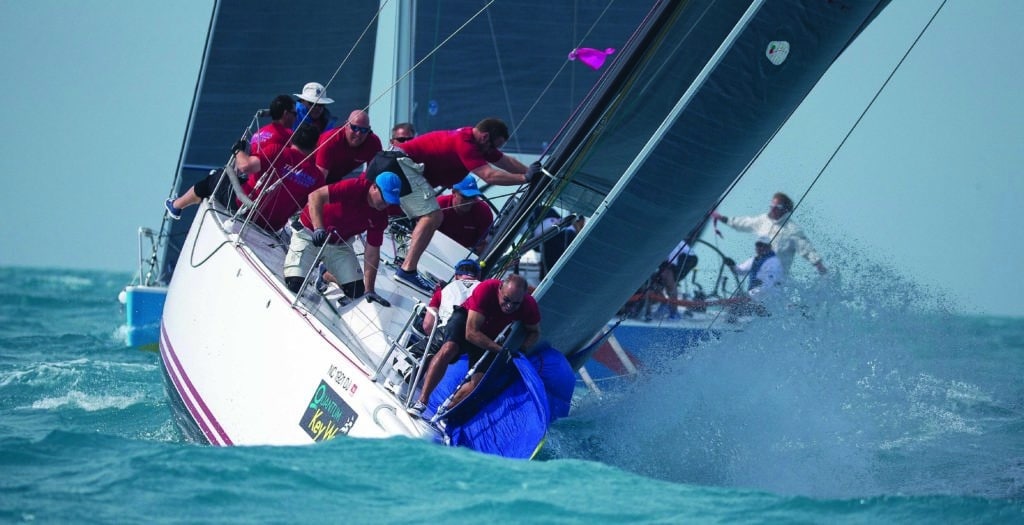
2015 KWRW 2015
Since taking over management of Quantum Key West Race Week, the Storm Trysail Club has implemented changes designed to re-energize the iconic regatta. The most controversial is the scuttling of PHRF classes, to be replaced by Offshore Racing Congress classes.
Race committee chairman Dick Neville says the move is precipitated by declining interest in PHRF racing at the 28-year-old event. At its peak in 2004, Race Week attracted 111 boats in 11 PHRF classes. In 2015, there were only 13 PHRF entries.
In contemplating a replacement rule, STC preferred solutions offered by the Offshore Racing Congress, a rule used in more than 40 countries and sanctioned by the International Sailing Federation. “We had to face the reality that PHRF boats have been disappearing from the regatta, and the logical response is to offer a different rating system that’s more popular worldwide,” Neville says. “So we are encouraging owners who may have raced PHRF in the past to obtain an ORC Club certificate.”
Neville notes the ORC system will generate nearly 10,000 ORCi and ORC Club certificates in 2015. He’s hopeful that adopting the system will also boost foreign entries. ORC’s other advantages, says Neville, are that it’s a science-based, transparent system that can rate boats objectively without needing observational data, and that it eliminates local biases and provides three different ratings for windward-leeward courses based on wind strength. Certificates are available online, and test certificates can be run by the user.
Response so far has been tepid, although it is still early in the process, with the regatta scheduled for late January 2016. As of Oct. 1, there were six entries in ORC and one in the Performance Cruising class that will also utilize the rule.
Ben Hall has entered his modified Evelyn 32 in ORC, and admits he will be experimenting with the system just like everyone else. As vice president of Hall Spars and a member of STC, he agrees with Neville’s assessment that the regatta had to offer a different rating system.
“I think it’s a good move because something needed to be done to turn the tide,” says Hall. “Even if you get 15 or 20 boats because of ORC, you are reversing the trend.”
Hall has “absolutely no clue” how the Evelyn 32 will perform under ORC and says he doesn’t care. “My opinion is let’s try it. Maybe it will work and maybe it won’t,” he says.
John Edwards, owner of the Farr 30 Rhumb Punch, is currently entered in ORC, but remains undecided on whether he will ultimately compete with his boat or a chartered GP 26. A resident of Solomons, Maryland, he reviewed the last two years of ORC World and ORC European championships to see how the Farr 30 performed.
“I’m not sure how the system treats a sportboat like mine,” says Edwards. “From the results I saw, the Farr 30 didn’t do too well. It lost soundly to boats that I beat like a rented mule under PHRF.”
Dobbs Davis, communications manager for ORC, says such conclusions highlight a lack of knowledge about the system in the United States. Davis points out that Farr 30s can do well in ORC, having placed first and second in Group B at the recent ORC Italian National Championship . Edwards hasn’t missed Race Week since 2001 and is committed to the 2016 event no matter what. He has raced his J/29 and Farr 30 in one-design and PHRF at the regatta and experienced mixed success, winning some years and suffering deep finishes in others.
North Sails’ Jonathan Bartlett is program manager for Teamwork, the J/122 owned by Robin Team, of Lexington, North Carolina. Bartlett has applied for an ORC certificate. Like Edwards, Team is a devoted Key West competitor and is already entered in the 2016 regatta.
Bartlett says it’s likely that Teamwork will wind up in ORC. “It looks like a pretty good system to me. It takes more of a scientific approach to calculating a rating,” says Bartlett. “I think if an organization the stature of the Storm Trysail Club takes a chance on ORC, that means they believe in it. That says something.”









